小学英语教学设计典型案例
小学英语教育教学教案设计(精选9篇)

小学英语教育教学教案设计(精选9篇)(经典版)编制人:__________________审核人:__________________审批人:__________________编制单位:__________________编制时间:____年____月____日序言下载提示:该文档是本店铺精心编制而成的,希望大家下载后,能够帮助大家解决实际问题。
文档下载后可定制修改,请根据实际需要进行调整和使用,谢谢!并且,本店铺为大家提供各种类型的经典范文,如总结报告、心得体会、应急预案、会议记录、条据书信、合同协议、规章制度、教学资料、作文大全、其他范文等等,想了解不同范文格式和写法,敬请关注!Download tips: This document is carefully compiled by this editor. I hope that after you download it, it can help you solve practical problems. The document can be customized and modified after downloading, please adjust and use it according to actual needs, thank you!Moreover, our store provides various types of classic sample essays, such as summary reports, insights, emergency plans, meeting minutes, evidence letters, contract agreements, rules and regulations, teaching materials, essay summaries, and other sample essays. If you would like to learn about different sample formats and writing methods, please pay attention!小学英语教育教学教案设计(精选9篇)小学英语教育教学教案设计(精选9篇)2024-04-14 12:07:23小学英语教学设计(精选6篇)推荐度:小学英语教学设计范文最新6篇推荐度:热点范文英语(英文:English)是一种西日耳曼语支,最早被中世纪的英国使用,并因其广阔的殖民地而成为世界使用面积最广的语言。
小学英语教学案例集合13篇
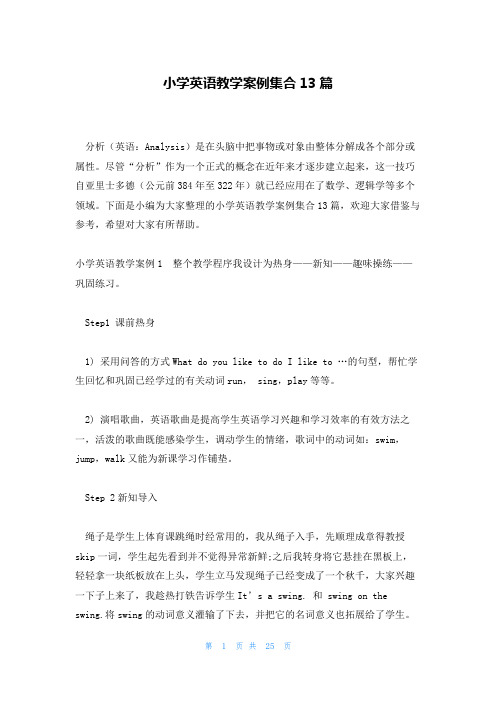
小学英语教学案例集合13篇分析(英语:Analysis)是在头脑中把事物或对象由整体分解成各个部分或属性。
尽管“分析”作为一个正式的概念在近年来才逐步建立起来,这一技巧自亚里士多德(公元前384年至322年)就已经应用在了数学、逻辑学等多个领域。
下面是小编为大家整理的小学英语教学案例集合13篇,欢迎大家借鉴与参考,希望对大家有所帮助。
小学英语教学案例1 整个教学程序我设计为热身——新知——趣味操练——巩固练习。
Step1 课前热身1) 采用问答的方式What do you like to do I like to …的句型,帮忙学生回忆和巩固已经学过的有关动词run, sing,play等等。
2) 演唱歌曲,英语歌曲是提高学生英语学习兴趣和学习效率的有效方法之一,活泼的歌曲既能感染学生,调动学生的情绪,歌词中的动词如:swim,jump,walk又能为新课学习作铺垫。
Step 2新知导入绳子是学生上体育课跳绳时经常用的,我从绳子入手,先顺理成章得教授skip一词,学生起先看到并不觉得异常新鲜;之后我转身将它悬挂在黑板上,轻轻拿一块纸板放在上头,学生立马发现绳子已经变成了一个秋千,大家兴趣一下子上来了,我趁热打铁告诉学生It’s a swing. 和 swing on the swing.将swing的动词意义灌输了下去,并把它的名词意义也拓展给了学生。
之后在魔术音乐的配合下,我又添了三个横竿在swing上,大家笑着发现swing已经变成了ladder,同时引出动词climb. 最终,同样在音乐的配合下,我又使绳子成为了一个能够飞翔的风筝,引出了fly,取得了较好的效果。
我根据skip, swing, climb, fly几个单词的共同特点,利用一根magic rope将这些新授单词串联了起来。
既自然过渡了新授资料,又使学生学习起来具趣味味性。
此外,我在教授skip时以声调的变化,教swing时以动作的变化,教climb时以物体的变化,教fly时以动画的形式并配以问答链来丰富学生对新词的操练,避免单调和乏味。
小学英语教案(优秀3篇)
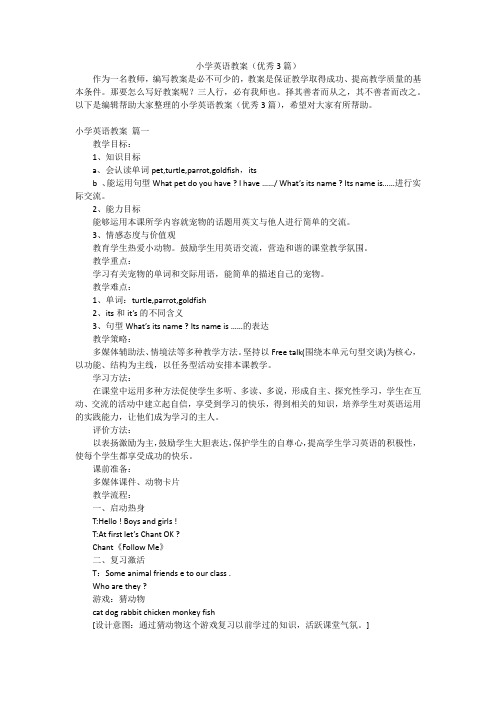
小学英语教案(优秀3篇)作为一名教师,编写教案是必不可少的,教案是保证教学取得成功、提高教学质量的基本条件。
那要怎么写好教案呢?三人行,必有我师也。
择其善者而从之,其不善者而改之。
以下是编辑帮助大家整理的小学英语教案(优秀3篇),希望对大家有所帮助。
小学英语教案篇一教学目标:1、知识目标a、会认读单词pet,turtle,parrot,goldfish,itsb 、能运用句型What pet do you have ? I have ……/ What’s its name ? Its name is……进行实际交流。
2、能力目标能够运用本课所学内容就宠物的话题用英文与他人进行简单的交流。
3、情感态度与价值观教育学生热爱小动物。
鼓励学生用英语交流,营造和谐的课堂教学氛围。
教学重点:学习有关宠物的单词和交际用语,能简单的描述自己的宠物。
教学难点:1、单词:turtle,parrot,goldfish2、its和it’s的不同含义3、句型What’s its name ? Its name is ……的表达教学策略:多媒体辅助法、情境法等多种教学方法。
坚持以Free talk(围绕本单元句型交谈)为核心,以功能、结构为主线,以任务型活动安排本课教学。
学习方法:在课堂中运用多种方法促使学生多听、多读、多说,形成自主、探究性学习,学生在互动、交流的活动中建立起自信,享受到学习的快乐,得到相关的知识,培养学生对英语运用的实践能力,让他们成为学习的主人。
评价方法:以表扬激励为主,鼓励学生大胆表达,保护学生的自尊心,提高学生学习英语的积极性,使每个学生都享受成功的快乐。
课前准备:多媒体课件、动物卡片教学流程:一、启动热身T:Hello ! Boys and girls !T:At first let’s Chant OK ?Chant《Follow Me》二、复习激活T:Some animal friends e to our class .Who are they ?游戏:猜动物cat dog rabbit chicken monkey fish[设计意图:通过猜动物这个游戏复习以前学过的知识,活跃课堂气氛。
小学英语教学案例分析(共5篇)
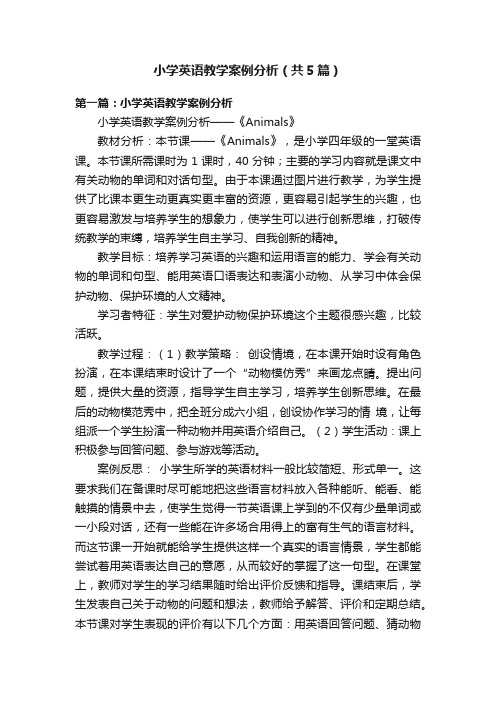
小学英语教学案例分析(共5篇)第一篇:小学英语教学案例分析小学英语教学案例分析——《Animals》教材分析:本节课——《Animals》,是小学四年级的一堂英语课。
本节课所需课时为 1 课时,40 分钟;主要的学习内容就是课文中有关动物的单词和对话句型。
由于本课通过图片进行教学,为学生提供了比课本更生动更真实更丰富的资源,更容易引起学生的兴趣,也更容易激发与培养学生的想象力,使学生可以进行创新思维,打破传统教学的束缚,培养学生自主学习、自我创新的精神。
教学目标:培养学习英语的兴趣和运用语言的能力、学会有关动物的单词和句型、能用英语口语表达和表演小动物、从学习中体会保护动物、保护环境的人文精神。
学习者特征:学生对爱护动物保护环境这个主题很感兴趣,比较活跃。
教学过程:(1)教学策略:创设情境,在本课开始时设有角色扮演,在本课结束时设计了一个“动物模仿秀”来画龙点睛。
提出问题,提供大量的资源,指导学生自主学习,培养学生创新思维。
在最后的动物模范秀中,把全班分成六小组,创设协作学习的情境,让每组派一个学生扮演一种动物并用英语介绍自己。
(2)学生活动:课上积极参与回答问题、参与游戏等活动。
案例反思:小学生所学的英语材料一般比较简短、形式单一。
这要求我们在备课时尽可能地把这些语言材料放入各种能听、能看、能触摸的情景中去,使学生觉得一节英语课上学到的不仅有少量单词或一小段对话,还有一些能在许多场合用得上的富有生气的语言材料。
而这节课一开始就能给学生提供这样一个真实的语言情景,学生都能尝试着用英语表达自己的意愿,从而较好的掌握了这一句型。
在课堂上,教师对学生的学习结果随时给出评价反馈和指导。
课结束后,学生发表自己关于动物的问题和想法,教师给予解答、评价和定期总结。
本节课对学生表现的评价有以下几个方面:用英语回答问题、猜动物的英文名、上网找动物资料、制作电子贺卡、发送电子邮件、网上讨论区中发表的观点、与他人合作扮演某一种动物,表演时用英语对话.Internet 学习环境在英语口语教学中的应用的教学模式由六部分组成:眼观情境,自我练说,耳听他说,协作合说,互相评说、迁移练说。
小学英语教师工作案例(5篇)

小学英语教师工作案例(5篇)案例一:游戏学习法背景小学英语教师在教授课程时,发现学生对于单词的记忆效果不佳,缺乏兴趣和动力。
解决方案教师决定采用游戏学习法来提高学生的学习积极性。
他设计了各种有趣的英语游戏,如单词接龙、角色扮演等,让学生在游戏中学习和巩固英语知识。
结果通过游戏学习法,学生的学习兴趣得到了激发,记忆效果也明显提高。
学生们更加积极参与课堂,英语成绩也有所提升。
案例二:情境教学法背景小学英语教师发现学生在运用英语进行真实情境对话时存在困难,缺乏实际应用能力。
解决方案教师决定采用情境教学法来帮助学生提升英语口语能力。
他设计了各种日常生活情境,如购物、旅行等,让学生在情境中进行真实对话练习。
结果通过情境教学法,学生的英语口语能力得到了明显提升。
他们在真实情境中的对话更加流利自然,也更加自信地运用英语进行交流。
案例三:多媒体辅助教学背景小学英语教师发现学生对于课堂上的教材内容理解不深,学习效果有待提高。
解决方案教师决定采用多媒体辅助教学来提升学生的学习效果。
他使用投影仪和电脑,将教材内容制作成动画、视频等多媒体形式,以图文并茂的方式呈现给学生。
结果通过多媒体辅助教学,学生对于课堂内容的理解得到了提升。
他们对于图文并茂的教材更加感兴趣,学习效果也明显提高。
案例四:小组合作学习背景小学英语教师发现学生在合作学习中存在困难,互动和交流不够流畅。
解决方案教师决定采用小组合作学习来提升学生的互动和交流能力。
他将学生分成小组,让他们在小组内共同完成任务,通过合作学习来提高英语口语和写作能力。
结果通过小组合作学习,学生的互动和交流能力得到了提升。
他们在小组中更加积极参与讨论和交流,英语口语和写作能力也得到了明显提高。
案例五:个性化学习背景小学英语教师发现学生在学习进度上存在差异,有的学生进度较快,有的学生进度较慢。
解决方案教师决定采用个性化学习来满足学生的不同学习需求。
他根据学生的水平和进度,设计了个性化的学习计划和任务,给予不同的辅导和指导。
英语教学案例范文10篇
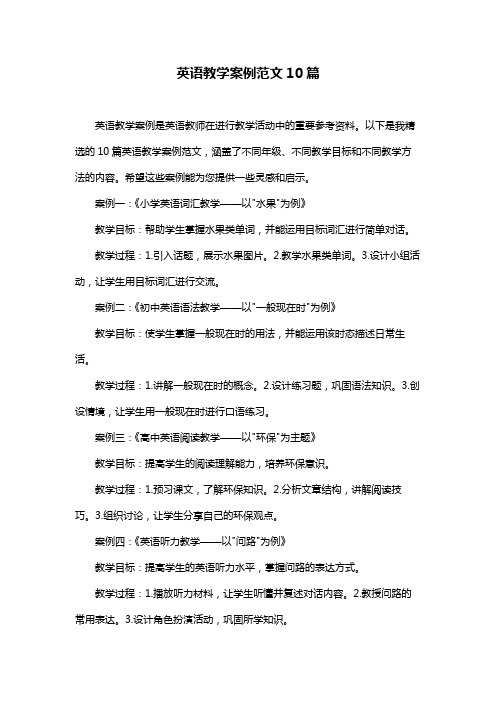
英语教学案例范文10篇英语教学案例是英语教师在进行教学活动中的重要参考资料。
以下是我精选的10篇英语教学案例范文,涵盖了不同年级、不同教学目标和不同教学方法的内容。
希望这些案例能为您提供一些灵感和启示。
案例一:《小学英语词汇教学——以"水果"为例》教学目标:帮助学生掌握水果类单词,并能运用目标词汇进行简单对话。
教学过程:1.引入话题,展示水果图片。
2.教学水果类单词。
3.设计小组活动,让学生用目标词汇进行交流。
案例二:《初中英语语法教学——以"一般现在时"为例》教学目标:使学生掌握一般现在时的用法,并能运用该时态描述日常生活。
教学过程:1.讲解一般现在时的概念。
2.设计练习题,巩固语法知识。
3.创设情境,让学生用一般现在时进行口语练习。
案例三:《高中英语阅读教学——以"环保"为主题》教学目标:提高学生的阅读理解能力,培养环保意识。
教学过程:1.预习课文,了解环保知识。
2.分析文章结构,讲解阅读技巧。
3.组织讨论,让学生分享自己的环保观点。
案例四:《英语听力教学——以"问路"为例》教学目标:提高学生的英语听力水平,掌握问路的表达方式。
教学过程:1.播放听力材料,让学生听懂并复述对话内容。
2.教授问路的常用表达。
3.设计角色扮演活动,巩固所学知识。
教学目标:培养学生的英语写作能力,学会用英语记录生活。
教学过程:1.讲解日记的格式和写作技巧。
2.提供写作素材,指导学生进行创作。
3.互相批改,提高写作质量。
案例六:《英语口语教学——以"旅游"为例》教学目标:提高学生的英语口语水平,学会用英语描述旅游景点。
教学过程:1.展示旅游景点图片,引导学生用英语进行描述。
2.教授相关表达,如:询问景点信息、推荐旅游景点等。
3.组织口语交流,让学生互相分享旅游经历。
案例七:《英语课堂教学游戏设计——以"猜词游戏"为例》教学目标:激发学生学习英语的兴趣,提高课堂参与度。
小学英语学科教育教学实践案例(3篇)
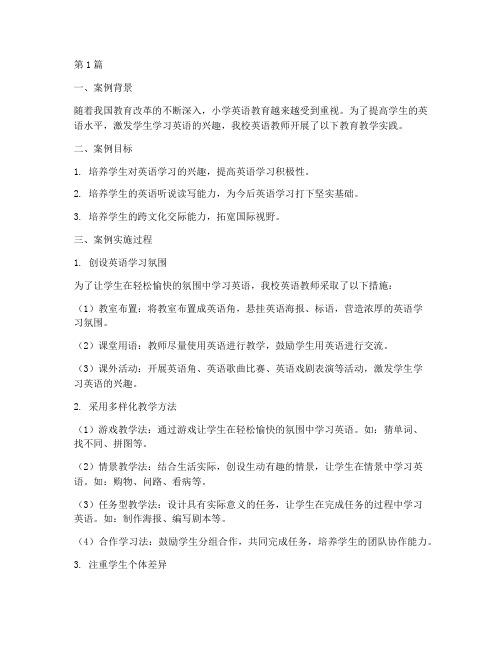
第1篇一、案例背景随着我国教育改革的不断深入,小学英语教育越来越受到重视。
为了提高学生的英语水平,激发学生学习英语的兴趣,我校英语教师开展了以下教育教学实践。
二、案例目标1. 培养学生对英语学习的兴趣,提高英语学习积极性。
2. 培养学生的英语听说读写能力,为今后英语学习打下坚实基础。
3. 培养学生的跨文化交际能力,拓宽国际视野。
三、案例实施过程1. 创设英语学习氛围为了让学生在轻松愉快的氛围中学习英语,我校英语教师采取了以下措施:(1)教室布置:将教室布置成英语角,悬挂英语海报、标语,营造浓厚的英语学习氛围。
(2)课堂用语:教师尽量使用英语进行教学,鼓励学生用英语进行交流。
(3)课外活动:开展英语角、英语歌曲比赛、英语戏剧表演等活动,激发学生学习英语的兴趣。
2. 采用多样化教学方法(1)游戏教学法:通过游戏让学生在轻松愉快的氛围中学习英语。
如:猜单词、找不同、拼图等。
(2)情景教学法:结合生活实际,创设生动有趣的情景,让学生在情景中学习英语。
如:购物、问路、看病等。
(3)任务型教学法:设计具有实际意义的任务,让学生在完成任务的过程中学习英语。
如:制作海报、编写剧本等。
(4)合作学习法:鼓励学生分组合作,共同完成任务,培养学生的团队协作能力。
3. 注重学生个体差异针对学生个体差异,教师采取以下措施:(1)分层教学:根据学生的英语水平,将学生分为A、B、C三个层次,分别制定教学目标,确保每个学生都能得到充分发展。
(2)个性化辅导:针对学生的薄弱环节,进行有针对性的辅导,提高学生的学习效果。
(3)鼓励学生积极参与:鼓励学生大胆发言,勇于表达自己的观点,培养学生的自信心。
四、案例效果通过以上教育教学实践,我校英语学科取得了以下成果:1. 学生的英语学习兴趣明显提高,课堂参与度明显增强。
2. 学生的英语听说读写能力得到全面提升,英语成绩稳步提高。
3. 学生的跨文化交际能力得到锻炼,拓宽了国际视野。
五、案例反思1. 教师要关注学生的个体差异,制定合适的教学策略,提高教学质量。
小学英语教学案例10篇

小学英语教学案例10篇案例1:动物名称教学目标:教授学生认识和发音不同动物的名称策略:使用图片和音频资料帮助学生研究动物的名称和发音步骤:1. 准备一些图片和音频资料,包括不同动物的图片和对应的发音录音。
2. 引导学生观察图片,鼓励他们说出动物的名称。
3. 播放动物名称的发音录音,让学生跟读。
4. 分组练:将学生分成小组,每个小组选择一张图片,描述图片中的动物并说出名称。
5. 小组展示:每个小组派一名代表展示他们选择的动物,并说出名称。
案例2:颜色识别游戏目标:帮助学生认识和记忆不同颜色的英文名称策略:通过游戏的方式让学生积极参与,提高对颜色名称的记忆力步骤:1. 准备彩色卡片或小物品,每种颜色至少两个。
2. 将学生分成小组,每个小组分配一些彩色卡片或小物品。
3. 教授学生不同颜色的英文名称,让他们跟读并记忆。
4. 进行游戏:教师喊出一个颜色的英文名称,学生需要迅速找到相应的彩色卡片或小物品。
5. 游戏结束后,可以根据表现给予奖励或表扬。
案例3:日常用语教学目标:教授学生日常生活中常用的英语表达策略:通过情景模拟和角色扮演的方式让学生在实际交流中研究日常用语步骤:1. 准备一些日常生活中常用的英语表达,如问候、道歉、感谢等。
2. 将学生分成小组,每个小组分配一个情景,如在超市购物、在餐厅点餐等。
3. 学生在小组中练对话,使用目标语言表达日常用语。
4. 小组展示:每个小组派一名代表进行情景模拟,并使用目标语言进行交流。
5. 教师给予反馈和指导,鼓励学生积极参与。
案例4:数字计数游戏目标:帮助学生掌握数字的读写和计数策略:通过游戏的方式提升学生对数字的兴趣和记忆力步骤:1. 准备一些数字卡片或小物品,从1到10。
2. 将学生分成小组,每个小组分配一些数字卡片或小物品。
3. 教授学生数字的读法和计数方法。
4. 进行游戏:教师喊出一个数字,学生需要迅速找到相应的数字卡片或小物品,并进行计数。
5. 游戏结束后,可以根据表现给予奖励或表扬。
- 1、下载文档前请自行甄别文档内容的完整性,平台不提供额外的编辑、内容补充、找答案等附加服务。
- 2、"仅部分预览"的文档,不可在线预览部分如存在完整性等问题,可反馈申请退款(可完整预览的文档不适用该条件!)。
- 3、如文档侵犯您的权益,请联系客服反馈,我们会尽快为您处理(人工客服工作时间:9:00-18:30)。
Step Four: Extension ( Use the sentence to ask and answer. )
1) What can you do? I can dance.
2) Can he swim? Yes, he can.
本课是第七册教材中的一个对话教学,其中重点复习情态动词 can 的用法,这个词的用 法学生已有过学习,因此,学生在总结该词的用法时比较容易,加上这个班上个学期刚刚开 完有关奥运知识的班会,我把本节课和学生已有的奥运知识联系起来,极大地调动了学生的 积极性。
为了调动学生参与课堂,我设计了多种评价方式,有个人评价,也有小组评价,并针对 学生在课堂上的表现,及时进行表扬,虽然时间有限,但是,我让学生参与评价,不但节约 了时间,而且使评价更具有公正性。
利用福娃引入复习要点,既向 学生渗透了奥运知识,又能充 分调动起学生学习的兴趣。 逐一播放图片,讲述奥运福娃 知识,引出本课教学重点 can 课件播出“I can……”图形与 声音配合,给学生直观印象, 又给学生做出示范。
结合图片,复习涉及的 5 个动 词,加深学生印象。
Say: Each animal has its own ability, too. Listen to the rhyme and remember these words. Display the cartoons of the rhyme.
Look and listen to the rhyme.
Listen to the teacher and complete the sentences together.
利用师大版教材相关内容,既 做到教材的整合,动画的播 放,再一次调动学生的学习兴 趣,加深对 can 句型应用的理 解。
Then, the teacher read a part
内容:⒈行为动词的总结复习;⒉情态动词 can 的用法归纳;⒊对话教学;⒋
扩展训练,通过问答,完成调查表,并进行相关的写作训练;⒌结合生活实际,
教学内容 巩固 can 的用法。在处理这五部分的教学内容时,我把重点放在了情态动词 can
的用法上,让学生通过看、听、说、写等练习,巩固句型及其用法。在对话教
1) Listen and answer the questions according to the dialogue.
2) Teach the new words.
Make a survey in the class. Then: 1) Read aloud the survey. 2) Write a short passage.
Make models on the blackboard. I can walk. I can read. I can sing. I can play basketball.
Then, have them use these words ask and answer in groups. ( Ordered everyone must use different words.)
二、学习者分析
本节课的教学对象是房山区窦店中心校芦村完全小学六年级的学生,该班学生在英语学 习上普遍存在着浓厚的兴趣,能够积极按照老师要求进行学习,作为即将毕业的学生,他们 在英语的听、说、读、写方面已经奠定了比较坚实的基础。六年级的学习我把重点放在了知 识的总结和复习上,为了使学生牢固掌握以往所学知识,在教学的过程中,教师起到了引路 的作用,帮助学生归纳整理知识,从而提高复习效果。
of the sentences. Have them
listen and complete together.
An elephant can
.
A frog can
.
A fish can
.
An egg can
.
An elephant can walk.. A frog can jump.. A fish can swim. An egg can roll.
和形成自主学习能力的过程。在本节课的设计上,我以对话教学作为这堂课的
主线,贯穿课堂始终。一切教学活动都围绕这一主线展开。在设计每一环节的
活动时,都采用了适时适度的评价方式,激发了学生的学习兴趣。
本节课是北京版教材小学英语六年级第七册 Unit Four 中 Lesson One 《Can He
Speak Chinese?》。在教学过程中,围绕这一课题,我设计了以下五个部分的学习
确理解词义,读准字音。 ⒈能够准确运用情态动词 can 进行相关的能力问答; ⒉通过学习,提高学生的听力水平和自学水平。
教学重点 ⒈复习巩固情态动词 can 的用法;
⒉对话教学。
教学难点 ⒈通过学习,感悟情态动词 can 的用法,并能准确运用,
⒉教给学生学习方法,学会及时归纳整理。
教具准备 图片、卡片、录音机、多媒体课件
2)Take out the pictures of FuWa. Ask: Do you know their names?
Show every FuWa on the screen. Introduce them one by one. Elicit “can”. Say: Beibei is a fish.
Have one or two groups do the chain-game. Have the good color the stars. ( five, four, three,……)
Listen to the question and answer to it. Elicit the answer:
小学英语教学设计案例
一、教学内容分析
《英语课程标准》中明确指出,基础教育阶段英语课程的任务之一是:激
发和培养学生学习英语的兴趣,使学生树立自信心,养成良好的学习习惯和形
成有效的学习策略,发展自主学习的能力和合作精神;使学生掌握一定的英语
指导 思想与 理论基础
基础知识和听、说、读、写技能,形成一定的综合语言运用能力。并强调从学 生的学习兴趣、生活经验和认知水平出发,倡导体验、实践、参与、合作与交 流的学习方式和任务型的教学途径,发展学生的综合语言运用能力,使语言学 习的过程为学生形成积极的情感态度、主动思维和大胆实践、提高跨文化意识
Look at the FuWa and answer the teacher’s question. Beibei can swim. Jingjing, Huanhuan, Yingying, and Nini. Read the verbs together.
引领学生进入英语学习状态, 为课上的练习作好铺垫。
She said: “I can swim.” ( Broadcast from the PPT.)
Jingjing is a panda. He said: “I can walk.” Huanhuan is fire. She said: “I can dance.” Yingying is a Tibet antelope. She said: “I can run.” Nini is a bird. She said: “I can fly.” Next, point to each FuWa on the blackboard. Ask: What can they do?
I can…… Someone answers. Others listen and remember. Then, look at the screen. Read the words together. walk, run, swim, read, write, sing, dance, pay basketball, play football, pay the piano,
1) Summary the class with the students.
2) Set homework.
四、Teaching process
Teacher’s Activity
Students’ Activity
Purpose of Design
Step 1: Warm-up:
1) Ask some questions about their names, ages, and some information about the personal life. Q: What’s your name? May I have your name? How old are you? Where are you from? What’s the date? What day is today?
Point to each picture, have them read the verbs again.
Listen and answer the teacher’s questions according to their real life.
A: My name’s…. I’m….. I’m…. I’m from…. I come from…. It’s ….
再一次强调动词,既为学生练 习提供材料,又能强调 can 的 用法。
Step 2: Review:
Say: What can you do? ( Write down this question on the blackboard. ) Have someone answer the question. Then, help them summary the words on the PPT.
daddy, culture, beginner What can you 务型教学法、多媒体教学
